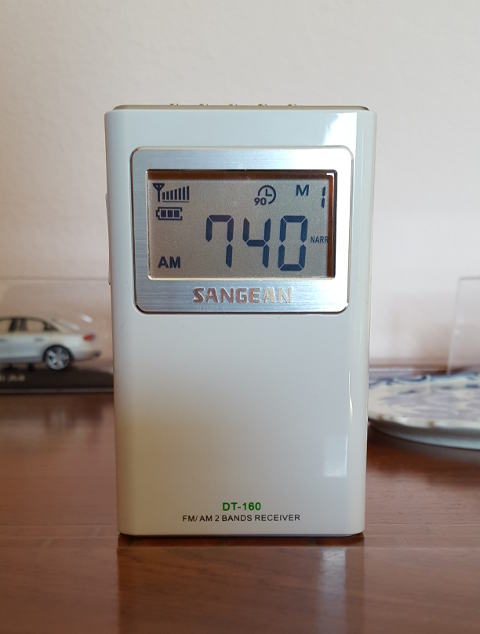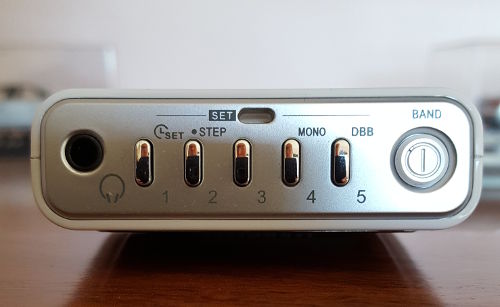
Radio description and features
At first glance, it appeared to be targeted toward users of other Sangean models, in particular, the longstanding DT-200VX/DT-200X and the equally venerable DT-400W. A quick glance, however, indicates one big difference: the DT-160 does not have a speaker. It's strictly a headphone radio.
An initial test drive indicated that performance, in terms of the number of stations received, might not be as good as other DSP radios. A subsequent head-to-head test alleviated those concerns. But, first, let's focus on the radio's features.
The DT-160 was unique among DSP radios in that it has dual bandwidths both on AM and FM. Having a selection of AM bandwidths was not unusual for DSP-based radios, but having a selection of FM bandwidths was something different.
The two AM audio bandwidths don't seem to differ much. In the owner's manual for this radio, Sangean doesn't specify either of the bandwidths; as best as I can estimate, the normal setting is for a 3 kHz bandwidth while the narrow setting is for 2 kHz. Either one makes music sound fairly unpleasant (if you are in an area where there is an AM station actually playing music, something that's increasingly hard to find); the narrow setting makes all programming sound muddy and unpleasant. Only DXers will find it useful.
The effect of the narrow bandwidth on FM is far subtler than it is on AM, and usually causes minimal degredation of audio quality. In theory, on FM, a narrower bandwidth should make it easier to pick out weak signals, especially if they are next to a strong signal. The narrow FM bandwidth setting did not seem to do any harm, but I didn't notice much of a difference. The Sangean's owner's manual warns that the narrow setting may cause the loss of FM stereo reception on weak signals. Given that weak signals are likely not to be in stereo anyway, this doesn't seem to be a problem with normal usage.
Aside from the large, easy-to-read display, and the availability of multiple bandwidths on AM and FM, one of the most distinctive things on this radio is the tuning wheel on the right side of the unit. It can be used to tune up and down in steps, or to scan up or down to the next available station. Pushing the wheel inward puts the unit in settings mode. A SET indicator appears, and the memory buttons on the top of the unit acquire additional functions.

The additional functions are:
- 1: Set time.
- 2: With the radio off, shows the version of software running. A longer press enables changing tuning steps. For AM, the choices are 10 kHz steps for the Western Hemisphere or 9 kHz for the rest of the world. For FM, the choices are either 100 kHz steps, the default, or 50 kHz steps.
- 4: Forces mono reception of all FM stations.
- 5: Toggles "Dynamic Bass Boost", similar to other Sangean radios.
- Volume Up (+): Toggles bandwidth settings on both AM and FM.
The volume control is a bar on the left side of the unit. Push the top, labeled "+" to increase volume; "-" to decrease it. The power button also doubles as a button to select between the AM and FM bands.
Radio performance
How does the radio perform? As I indicated at the start of this review, early signs weren't promising. But then I performed a head-to-head comparison at high noon one summer day, to minimize any unusual propagation on either AM or FM.
The radios used for comparison were similarly sized pocket radios: the CC Pocket (v2) on AM and FM, plus the Degen DE1123 on FM only. On FM, all three were very close in sensitivity, judged by the number of stations received - 48 for the Sangean, 46 for the CC Pocket. (Degen: 50, but those added four were very weak.) The DT-160 and the CC Pocket were identical in number of stations received and the quality of signal received; the Degen was just slightly better. On AM, the Sangean and the CC Pocket were exact equals. The CC Pocket does a better job here. The dual FM bandwidth feature on the Sangean made a very weak signal from Napa's KVYN more listenable, though still weak and in mono. That was the only effect it seemed to have. It won't work miracles but it might help in DX chasing, if that's even possible on the currently overcrowded FM band.
Generally speaking, AM audio recovery was good. AM section was free from digital noises. FM sensitivity was good. FM selectivity was exceptional when the narrow bandwidth is used; otherwise, it was still very good.
So far, so good. However, having relatively few memory settings is disappointing. There are only five presets per band. Note that there are two FM "bands", both covering all the FM band, meaning that there are actually ten FM presets total. But there are only five AM presets.
Having AM/FM band selection on the power button also takes some getting used to. A long press is required to turn the unit on or off. A shorter press switches between bands. This is a minor ergonomic fault, but one that should still be noted.
If this radio had a speaker, I'm sure it would be a contender with Sangean's existing pocket radios and the CC Pocket. The selection of AM audio bandwidths could be better: for example, 4 kHz rather than 3 kHz as the default. Having a narrower FM bandwidth available may help in some locations. Overall, if you can accept the limitations of headphone-only operation, and a limited number of memory slots (also a restriction with the non-DSP Sangean units and the CC Pocket), then I think you could find this radio to be acceptable. Still, I think there are more capable pocket-sized radios available, such as the CC Pocket and Sangean's own DT-400W.
Nine years later
I've ended up using the DT-160 a lot, but mostly as a clock. In the middle of the night, it's very handy to push any button and have the display light up with the time, easily seen even when I'm half-asleep. It's also easy to travel with the DT-160, since it's compact and fits just about anywhere in a suitcase.
Battery life has been excellent. When the battery is low, the color of the display lighting changes from yellow to green. I don't know if this is a feature or just something that happens with low battery current. But it's quite useful.
The DT-160 matches well with earbuds such as Apple EarPods. The case's white color also complements the white Apple earbuds. The "Dynamic Bass Boost" feature also does a good job of improving the audio quality of earbuds used with the radio. While I often end up using radios with more features, the DT-160 is a very good, simple radio, particularly on FM. When I revised this review in 2025, the radio was going for just over $40 on Amazon.